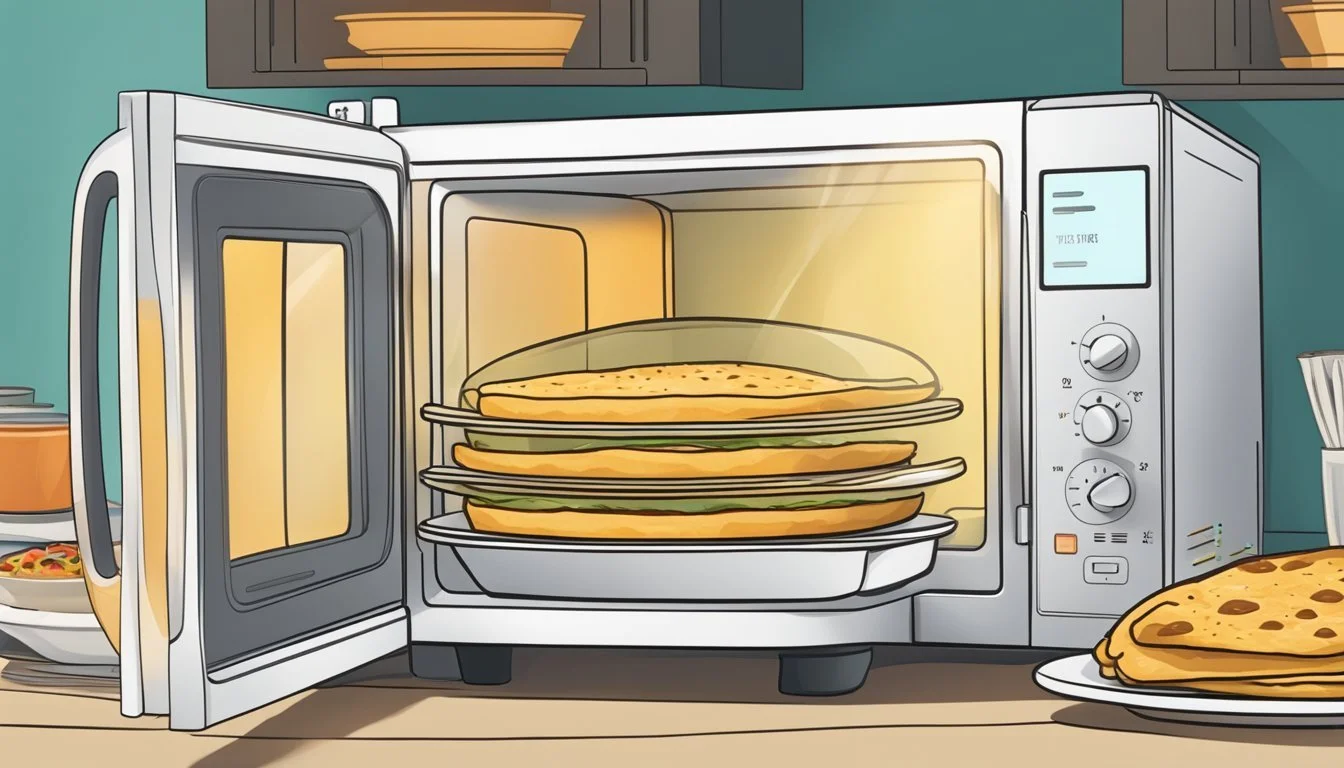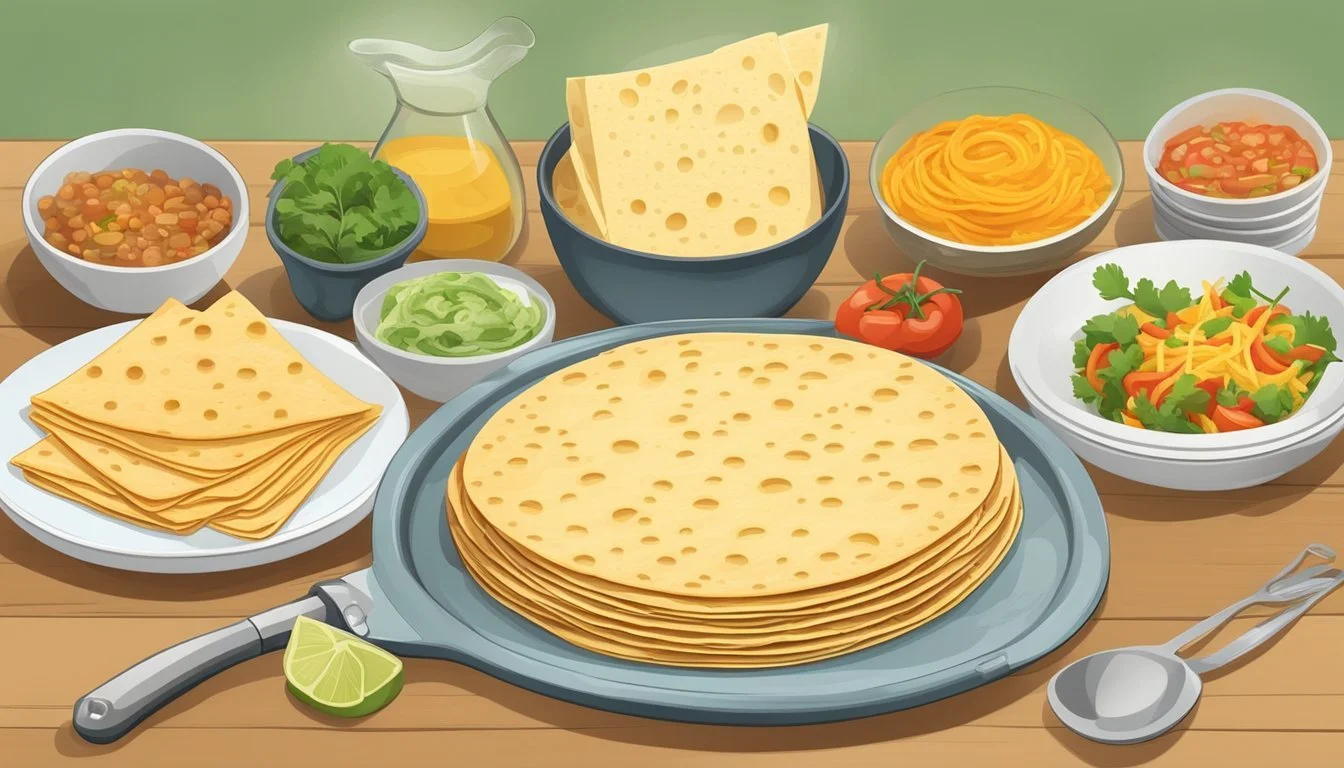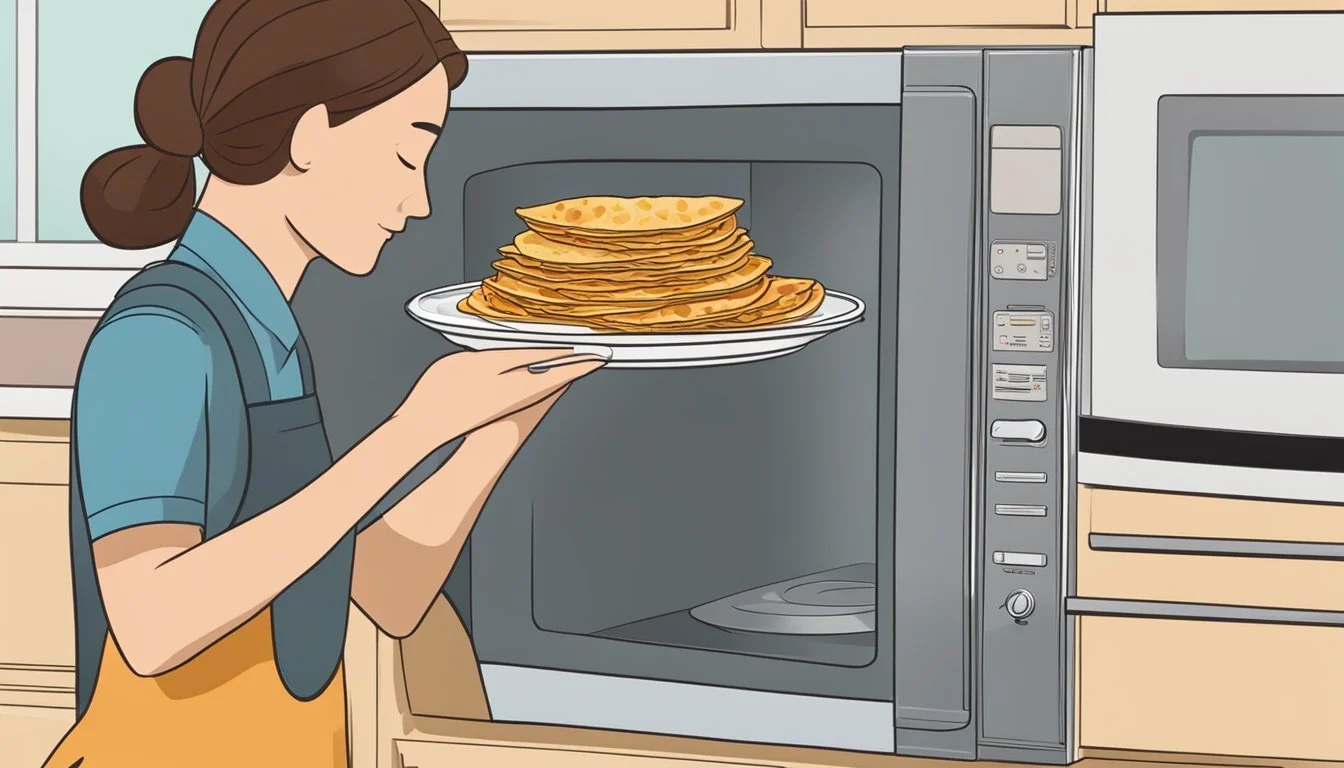How to Reheat Gluten-Free Quesadillas for Perfect Texture and Flavor
Gluten-free quesadillas can be a delightful and easy meal, whether made fresh or reheated as leftovers. Many may wonder how to keep them as tasty and crispy as when they were first created. The trick is choosing the right reheating method to maintain that perfect balance of a crispy exterior and a warm, melted inside.
For a quick and efficient reheating method, using a stovetop is highly effective. Heat a skillet over medium heat, add a thin layer of oil, preferably avocado or vegetable oil, and cook each side of the quesadilla for about a minute. This method ensures the quesadilla remains crispy and delicious without getting soggy.
Another reliable option is reheating in the oven. Preheat the oven to 350 degrees Fahrenheit and place the quesadilla directly on the oven rack. Let it bake for approximately 10 minutes to achieve an evenly heated, crispy treat. Whether you are dealing with freshly made or frozen quesadillas, these methods provide simple and quick solutions to enjoy your gluten-free leftovers to the fullest.
Understanding Gluten-Free Quesadillas
Gluten-free quesadillas require careful selection of tortillas and fillings to ensure they are both delicious and suitable for those with gluten sensitivities.
Identifying Gluten-Free Tortillas
Selecting the right tortilla is crucial. Gluten-free tortillas can be made from a variety of alternative flours such as corn, rice, or other gluten-free grains.
Corn tortillas are a popular choice due to their widespread availability and naturally gluten-free composition. Another option includes Toufayan gluten-free tortillas, known for their texture that closely mimics traditional flour tortillas. It's essential to check labels for cross-contamination warnings and certification to confirm they are genuinely gluten-free.
Choosing the Right Fillings
The fillings play a significant role in maintaining the nutritional balance and flavor of gluten-free quesadillas. Black beans and avocado are fantastic options, providing both fiber and healthy fats.
Adding protein such as grilled chicken or beef ensures the quesadilla is filling and satisfying. Cheese is a quintessential ingredient, melting perfectly with the other components. For those seeking extra nutrients, incorporating vegetables like bell peppers, onions, and spinach can enhance both the texture and taste.
Benefits of Gluten-Free Diet Choices
A gluten-free diet offers several advantages, particularly for those with celiac disease or gluten intolerance. It can help alleviate symptoms such as bloating, digestive discomfort, and fatigue. Gluten-free alternatives like gluten-free tortillas and other products have improved significantly in taste and texture.
By opting for gluten-free ingredients, individuals often unintentionally consume more whole foods such as fruits, vegetables, and lean proteins, contributing to overall health. Emphasizing naturally gluten-free foods like corn tortillas and avocado can help maintain a balanced diet while avoiding gluten-related issues.
Preparing for Reheating
Before you start reheating your gluten-free quesadillas, it's crucial to assemble them properly and follow a few preparation tips. This ensures that they retain their original taste and texture.
Assembling the Quesadillas
When assembling gluten-free quesadillas, choose tortillas that are sturdy enough to hold the fillings without breaking. Fill them with your preferred cheese such as cheddar cheese, Monterey Jack cheese, or even mozzarella for a stretchier texture. Vegan cheese is also an excellent option for dairy-free needs.
Layer the cheese evenly to avoid clumping. You may add other fillings like grilled vegetables or cooked chicken. Avoid adding too much as this can make the quesadillas soggy. Fold the tortillas in half and press lightly so that the fillings stay in place while reheating.
Pre-Reheating Tips
Take the quesadillas out of the refrigerator and let them sit at room temperature for about 15 minutes. This helps achieve even heating. Preheat your chosen reheating appliance: a skillet, oven, or air fryer.
For skillet reheating, set it to medium heat and lightly coat with cooking oil to prevent sticking. If using an oven, preheat to 350°F (175°C) and line a baking sheet with parchment paper. For an air fryer, set it to 350°F and lightly spray both sides of the quesadillas with cooking oil.
Following these steps will ensure that your gluten-free quesadillas are perfectly prepared for reheating, resulting in a delicious and satisfying meal.
Reheating Techniques
Reheating gluten-free quesadillas requires balancing the need for a crispy exterior with maintaining the integrity of the gluten-free tortilla. The following methods explore various options suitable for different needs and preferences.
Using a Skillet
Using a skillet to reheat gluten-free quesadillas can help achieve a crispy texture. Heat a medium-sized skillet over medium heat. Add a small amount of oil, such as avocado or vegetable oil, to avoid sticking and to enhance crispiness. Once the skillet is hot, place the quesadilla in the skillet and cook for 1-2 minutes on each side.
Flipping carefully is essential to prevent the gluten-free tortilla from breaking. For a richer flavor, a small amount of butter can be added with the oil. Ensure the quesadilla is evenly heated and golden brown before serving.
Oven Reheating Method
The oven method is ideal for reheating multiple quesadillas at once. Preheat the oven to 350°F (175°C).
Place the quesadillas directly on the oven rack or on a baking sheet lined with parchment paper to avoid sticking. Bake for about 10 minutes, checking halfway to ensure even heating. If reheating from frozen, extend the baking time by an additional 5-10 minutes. This method helps maintain the quesadillas' structure and flavor without making them soggy.
Microwave Tips
Reheating in the microwave is the quickest method but may not produce the same crispiness as other methods. Place the quesadilla on a microwave-safe plate and cover it with a damp paper towel. This helps retain moisture and prevents drying.
Heat in 30-second increments, checking after each interval to avoid overcooking and ensuring the cheese is melted evenly. It's important to consume immediately as gluten-free tortillas can become chewy if left to sit too long.
Air Fryer Instructions
An air fryer offers a balance between speed and crispiness. Preheat the air fryer to 350°F. Lightly spray the quesadillas with cooking oil, such as canola or olive oil, to enhance crispness without adding too much fat.
Place the quesadillas in the air fryer basket in a single layer. Cook for 3-4 minutes, flipping halfway through to ensure even heating. This method ensures a crispy exterior while keeping the inside warm and gooey.
Enhancing Your Quesadillas
Adding creative toppings and pairing them with tasty homemade sides can significantly elevate the flavor and enjoyment of your gluten-free quesadillas. From guacamole to caramelized onions, a variety of ingredients can be used to enhance both the taste and presentation.
Creative Toppings and Variations
Pepper Jack Cheese and Jalapeño: Boost the spiciness of your quesadillas by using shredded pepper jack cheese and adding thinly sliced jalapeños. This combination offers a complement of creamy and sharp flavors.
Caramelized Onions and Spinach: For a touch of sweetness, caramelized onions go perfectly with a handful of fresh spinach. This pairing adds both flavor and nutrition.
Guacamole or Homemade Guacamole: Topping your quesadillas with a dollop of creamy guacamole can add richness and moisture. Fresh, homemade guacamole with avocado, lime, and cilantro enhances the freshness.
Cilantro and Red Onion: For a zesty twist, sprinkle chopped fresh cilantro and finely diced red onion. This combination introduces a fresh, slightly pungent flavor that cuts through the richness of the cheese.
Bell Pepper: Add color and crunch with thinly sliced bell peppers. They provide a sweet and tangy note, balancing the cheesy and savory elements.
Homemade Sides and Condiments
Salsa: Offer a side of fresh salsa, made with tomatoes, onions, cilantro, and lime juice. It’s a versatile condiment that pairs well with most quesadilla variations.
Sour Cream: Serve a small bowl of sour cream for dipping. Its cool, creamy texture can balance spicier toppings like jalapeños.
Guacamole: A side of guacamole made fresh can be the perfect companion to any quesadilla. Combine mashed avocados with lime juice, salt, chopped cilantro, and finely diced red onion.
Caramelized Onions and Bell Pepper: These can also serve as sides, adding a mixture of sweet and savory flavors that enhance the quesadilla experience without overwhelming it.
By thoughtfully combining these toppings and sides, you can create a gluten-free quesadilla meal that is not only delicious but also visually appealing and satisfyingly varied.
Maintaining a Perfect Texture
Reheating gluten-free quesadillas while maintaining their perfect texture involves controlling moisture and achieving the right level of crispiness.
Avoiding Sogginess
To prevent sogginess, it’s crucial to control moisture. Reheating in a microwave can lead to a soggy texture due to trapped moisture. Instead, use a non-stick pan or an oven.
In an oven, place the quesadillas on a wire rack to allow air circulation.
Another method is using a skillet on medium heat with minimal oil. This ensures that excess moisture evaporates quickly. By using a spatula, you can press down gently, helping to expel any trapped steam and preventing a soggy texture.
Achieving the Ideal Crispiness
For ideal crispiness, consider an air fryer. Preheat the air fryer to 350ºF (180ºC). Lay the quesadilla flat and avoid stacking.
Reheat for 3-4 minutes or until crispy and the cheese melts.
Alternatively, on a stovetop, using medium heat in a skillet with a thin layer of avocado or vegetable oil can achieve similar results. Heat each side for about a minute, pressing down with a spatula. This helps evenly distribute heat and achieve perfect crispiness.
Dietary Considerations
When reheating gluten-free quesadillas, it's important to consider dietary preferences and common allergens to ensure that the meal remains suitable for various dietary needs. Special attention to vegan and vegetarian options as well as addressing common allergens like nuts and dairy is crucial.
Vegan and Vegetarian Options
For those following a vegan diet, it's necessary to use dairy-free cheese and ensure that the quesadillas contain no animal products. Brands like Daiya or Violife offer vegan cheeses that melt well.
Vegetarians can use regular cheese and fillings like beans, grilled vegetables, or tofu.
Preparation Tips:
Skillet: Heat skillet on medium, add a bit of oil, and cook for 1-2 minutes on each side.
Oven: Preheat to 350ºF and heat for about 10 minutes.
Lightly coat the skillet with oil to prevent sticking, which works well for both vegan and vegetarian quesadillas.
Addressing Common Allergens
Common allergens such as nuts, dairy, and eggs need careful consideration. To make your quesadillas dairy-free, opt for plant-based cheeses and avoid using egg-based products.
Nut-Free Options:
Ensure there are no nut-based oils or butters used in cooking.
Check labels for any potential cross-contamination.
Use vegan cheese alternatives like almond or soy-based options.
For those needing egg-free options, most quesadilla recipes naturally fit the bill. Always check ingredient lists to verify they are completely free from allergens.
By addressing these considerations, you can provide a safe and enjoyable meal for individuals with specific dietary needs.
Serving and Presentation
Proper serving and presentation can elevate the enjoyment of gluten-free quesadillas, making them visually appealing and enhancing their flavor profile. This section covers optimal cutting and plating techniques, as well as suggested accompaniments to complement the dish perfectly.
Cutting and Plating Techniques
Start by using a pizza cutter for clean and precise cuts. This ensures each piece maintains its structure and prevents crumbling, which can be an issue with gluten-free tortillas. Cut the quesadilla into triangles or strips, depending on whether it will be served as a main course or an appetizer.
When plating, arrange the pieces in a fan shape or circular pattern to add visual interest. Use a large, flat plate to avoid overcrowding. A sprinkle of fresh herbs such as cilantro or parsley makes for a vibrant garnish. Additionally, consider placing a small dipping bowl in the center of the plate if serving multiple pieces.
Suggested Accompaniments
Complement your gluten-free quesadillas with sides that enhance their flavor and balance their texture. Guacamole and salsa are both classic options that add freshness and acidity. A side of refried beans or Spanish rice can make the dish hearty enough for a dinner or lunch offering.
Adding a few lime wedges on the side allows guests to add a zesty kick. For a refined touch, consider a light salad with mixed greens, cherry tomatoes, and a simple vinaigrette. This adds both color and a refreshing crunch to the meal. A dollop of sour cream or a drizzle of spicy aioli can also be great for added flavor and for visual appeal.
By focusing on these details, you can turn reheated gluten-free quesadillas into a dish that's not only tasty but also attractive and satisfying.
Storage and Next-Day Enjoyment
To properly store gluten-free quesadillas, follow these simple guidelines.
Refrigeration Guidelines
Allow the quesadillas to cool to room temperature.
Place them in an airtight container or wrap them in aluminum foil.
Store in the refrigerator for up to 3 days.
Freezing
If you plan to keep the quesadillas for a longer period, consider freezing them.
Wrap each quesadilla individually in plastic wrap.
Place the wrapped quesadillas in a freezer-safe bag or container.
They can be stored in the freezer for up to 3 months.
Reheating Leftovers
When it's time to enjoy your leftover quesadillas, reheating correctly is key.
Skillet Method:
Heat a skillet over medium heat.
Optionally, add a light coat of oil.
Place the quesadilla in the skillet and heat for 1-2 minutes per side.
Oven Method:
Preheat the oven to 350°F (175°C).
Place the quesadilla directly on the oven rack.
Heat for about 10 minutes, or until warm.
Microwave Option
For a quick fix:
Place the quesadilla on a microwave-safe plate.
Heat using 30-second bursts until warmed through.
These methods ensure that the quesadillas stay crispy and delicious, even when enjoyed the next day.
Alternative Quesadilla Inspirations
Expanding the horizons of traditional gluten-free quesadillas allows for exciting and diverse flavors. From international spins to sweet twists, these creative options promise to surprise and delight.
International Flavors
An Italian quesadilla incorporates sun-dried tomatoes, mozzarella, and fresh basil. This mix brings the essence of a classic Italian pizza into a hand-held delight. Adding a dash of balsamic glaze before serving can elevate the flavors.
Greek-inspired quesadillas feature fillings like feta cheese, olives, and spinach. Pairing these with a garlic-infused olive oil for cooking enriches the Mediterranean taste.
For a spicy option, a Mexican cheese quesadilla packed with chorizo and poblano peppers delivers a burst of authentic Mexican flavors. Adding guacamole as a side enhances the dish, providing creaminess to balance the spice.
Sweet Quesadilla Creations
Apple cinnamon quesadillas provide a warm, comforting dessert. Thinly sliced apples combined with a sprinkle of cinnamon and a touch of honey create a delightful filling. Cooking these in a skillet until golden ensures the apples become tender and the cinnamon aroma permeates.
Another sweet option is the chocolate and banana quesadilla. Layers of sliced bananas and melted dark chocolate come together to satisfy any sweet tooth. Serving with a dollop of whipped cream or a scoop of vanilla ice cream can add an extra layer of decadence.
Feel free to experiment with seasonal fruits and spices to create a personalized sweet quesadilla that fits your palate.
Troubleshooting Common Issues
Reheating gluten-free quesadillas can sometimes present challenges such as texture issues or lacking specific ingredients. Addressing these common problems ensures a delicious result every time.
Fixes for Common Cooking Mistakes
Quesadilla Turns Out Soggy: Ensure the skillet is properly preheated. Using medium heat instead of high prevents burning while allowing even crisping. Avoid overcrowding the skillet; heat one quesadilla at a time.
Dry or Crumbly Texture: If the tortilla becomes too dry, lightly brush it with oil before reheating. For extra moisture, consider adding a touch of melted cheese.
Uneven Heating: Flip quesadillas halfway through cooking. Use an oven preheated to 350°F and place them directly on the rack for 10 minutes to promote even heat distribution.
Substitutions for Missing Ingredients
No Avocado or Vegetable Oil: Use olive oil or a small amount of butter as alternatives. Both provide the necessary fat content for crisping the tortilla without compromising flavor.
Missing Cheese: Substitute with dairy-free cheese options or a mix of hummus and nutritional yeast to maintain a creamy texture.
No Skillet Available: Reheat using an oven as mentioned or try a microwave with low power settings. Note that microwaved quesadillas tend to be less crispy but can be wrapped in a damp paper towel to avoid excessive dryness.
Alternative Ingredients: If specific gluten-free tortillas are unavailable, look for alternatives such as corn tortillas or other gluten-free wraps that can still achieve similar results when reheated properly.










